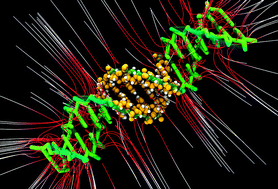A hybrid all-atom/coarse grain model for multiscale simulations of DNA†
Abstract
Hybrid simulations of molecular systems, which combine all-atom (AA) with simplified (or coarse grain, CG) representations, propose an advantageous alternative to gain atomistic details on relevant regions while getting profit from the speedup of treating a bigger part of the system at the CG level. Here we present a reduced set of parameters derived to treat a hybrid interface in DNA simulations. Our method allows us to forthrightly link a state-of-the-art force field for AA simulations of DNA with a CG representation developed by our group. We show that no modification is needed for any of the existing residues (neither AA nor CG). Only the bonding parameters at the hybrid interface are enough to produce a smooth transition of electrostatic, mechanic and dynamic features in different AA/CG systems, which are studied by molecular dynamics simulations using an implicit


 Please wait while we load your content...
Please wait while we load your content...